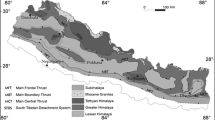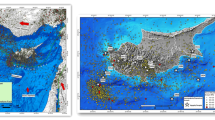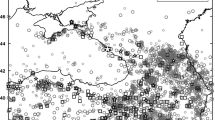Abstract
The paper illustrates some improvements in the seismic risk assessments in Italy and describes the differences deriving from the use of different approaches to calculate the losses and the influence exerted by different hazard results. The first method of risk evaluation, here termed as ‘direct’, evaluates the losses by using only the mean values of the main variables involved (rate of events and frequency of the damage levels), thus providing an approximation of the expected losses. The second method, named ‘probabilistic’, takes into account the uncertainties related to the number of events (hazard) and the damage levels (vulnerability), thus determine the probability associated to each level of loss. Both methods express the risk as the economic losses to dwellings within a reference period of time. Two alternative hazard results are also used to show the influence on the calculated risk: the first one considering the seismicity uniformly distributed within seismic source zones; the second one clustering the strong seismicity in geographically narrowed source zones and scattering the low seismicity over large source zones.
The results obtained show that the losses estimated by the ‘direct’ method are, at national level, a little bit lower than those obtained with the probabilistic method (about 6%). The differences are more pronounced at local level (regional or sub-regional), generally within ± 20% with larger values in the zones of lower risk. Nevertheless, also the two hazard results show more pronounced differences at local rather than at national scale. The risk estimates in the high seismicity areas are greater if using the seismic hazard results based on the clustered seismicity, but the reverse is true, in the low seismicity areas, if using the hazard results based on the uniformly distributed seismicity.
As a concluding remark, the direct method for calculating losses and the implementation of any seismic hazard result, may be acceptable for a general picture of the risk; whereas, when a detailed description of the territorial distribution of risk is needed, the probabilistic method for computing losses and a well-focused seismic hazard method should be used, as they are more pertinent to describe and highlight local differences
Similar content being viewed by others
References
Albarello, D., Bosi, V., Bramerini, F., Lucantoni, A., Naso, G., Peruzza, L., Rebez, A., Sabetta, F. and Slejko, D. (2000) Carte di pericolositá sismica del territorio nazionale. Quaderni di Geofisica, Vol. 12.
P. Angeletti A. Bellina E. Guagenti A. Moretti V. Petrini (1988) ArticleTitleComparison between Vulnerability Assessment and Damage Index: Some Results. Proceedings 9th World Conference on Earthquake Engineering 7 181–186
ATC, Applied Technology Council.(1985) Earthquake Damage Evaluation Data for California. ATC Report, 13, CA, USA.
D. Benedetti V. Petrini (1984) ArticleTitleOn seismic vulnerability of masonry buildings: proposal of an Evaluation Procedure. L’Industria delle costruzioni 18 66–78
Braga, F., Dolce, M. and Liberatore, D (1982) A statistical study on damaged buildings and ensuing review of the MSK-76 Scale. Proceedings 8th European Conference on Earthquake Engineering, Athens, September 1982.
F. Bramerini G. Pasquale ParticleDi G. Orsini A. Pugliese R.W. Romeo F. Sabetta (1995) ArticleTitleRischio sismico del territorio italiano. Proceedings 7th National Conference on Earthquake Engineering in Italy 3 1099–1108
R. Codermatz R. Nicolich D. Slejko (2003) ArticleTitleSeismic risk assessments and GIS technology: applications to infrastructures in the Friuli-Venezia Giulia region (NE Italy). Earthquake Engineering and Structural Dynamics 32 1677–1690
Colonna, E., Molina, C. and Petrini, V. (1994) Criteri di valutazione della vulnerabilità sismica del patrimonio edilizio esistente sul territorio nazionale. Ingegneria Sismica, n. 1, Gen-Apr. 1994.
C.A. Cornell (1968) ArticleTitleEngineering seismic risk analysis. Bulletin Seismological Society of America 58 1583–1606
Di Pasquale, G. and Goretti, A. (2001) Vulnerabilità Economica e Funzionale degli Edifici Residenziali Colpiti dai Recenti Eventi Sismici Italiani. Proceedings 10th National Conference on Earthquake Engineering in Italy, Potenza, Italy, September 2001.
G. Di Pasquale G. Orsini (1997) ArticleTitleProposta per la valutazione di scenari di danno conseguenti ad un evento sismico a partire dai dati ISTAT. Proceedings 8th National Conference on Earthquake Engineering in Italy 1 477–486
Di Pasquale, G. and Orsini, G. (1998) A probabilistic model for the assessment of the earthquake economic losses in Italy. Proceedings International Conference ‘Risk Analysis 98’, Valencia, Spain, 1998.
Di Pasquale, G., Orsini, G. and Serra, C. (1998a) Assessment of the economic loss from the DPC -- GNDT -- SSN Safety Evaluation Forms’’, Proceedings International Workshop on Measures of seismic damage tomasonry buildings, Monselice, June 1998, A.A. Balkema, Rotterdam, The Netherlands.
Di Pasquale, G., Orsini, G., Pugliese, A. and Romeo, R.W. (1998b) Damage scenario for future earthquakes. Proceedings 11th European Conference on Earthquake Engineering, Paris, France, September 1998.
Di Pasquale, G., Orsini, G. and Romeo, R.W. (2000) Sensitivity analysis in seismic risk assessment. Proceedings 6th International Conference on Seismic Zonation, Palm Spring (CA), October 2000.
Dolce M. (1996) Vulnerability Evaluation and Damage Scenarios. Proceedings US--Italy Workshop on Seismic Evaluation and Retrofit, New York City, December 1996.
FEMA (1999) HAZUS, estimated annualized earthquake losses for the U.S.A. Federal Emergency Management Agency, Washington DC.
E. Guagenti C. Molina G. Mulas (1988) ArticleTitleSeismic risk analysis with predictable models. Earthquake Engineering and Structural Dynamics 16 343–359
Kiremidjian, A.S., (1992). Methods for regional damage estimation. In Proceedings 10th World Conference on Earthquake Engineering, Madrid, Spain, July 1992, invited paper.
InstitutionalAuthorNameISTAT (1993) 13° censimento generale della popolazione e delle abitazioni. ISTAT Rome
S.V. Medvedev (1977) Seismic Intensity Scale MSK-76. Publication Institute of Geophysics of Poland, Academy of Sciences Varsaw, Poland
C. Meletti E. Patacca P. Scandone (2000) ArticleTitleConstruction of a Seismotectonic Model: the case of Italy. Pure and Applied Geophysics 157 IssueID1--2 11–35
G. Orsini (1999) ArticleTitleA model for buildings’ vulnerability assessment using the Parameterless Scale of Seismic Intensity (PSI). Earthquake Spectra 15 IssueID3 463–483
Postpischl, D., Ed. (1985a) Catalogo dei terremoti Italiani dall’anno 1000 al 1980. Quaderni della Ricerca Scientifica, 2A (114), CNR, Rome.
Postpischl, D., Ed. (1985b) Atlas of isoseismal maps. Quaderni della Ricerca Scientifica, 2B (114), CNR, Rome.
Pugliese, A., Romeo, R.W. and Sanò, T. (1998) Seismic zonation of Italy according to Eurocode 8.Proceedings 11th European Conference on Earthquake Engineering, CNIT, Paris la Dfense, France, September 1998.
Romeo, R.W. and Pugliese, A. (1997) La pericolosità sismica in Italia. Technical Report SSN/RT/97/1, National Seismic Survey, Rome, January 1997.
Romeo, R.W. and Pugliese, A. (1998) A global earthquake hazard assessment of Italy. Proceedings 11th European Conference on Earthquake Engineering, CNIT, Paris la Défense, France, September 1998.
R.W. Romeo A. Pugliese (2000) ArticleTitleSeismicity seismotectonics and seismic hazard of Italy. Engineering Geology 55 IssueID4 241–266
R.W. Romeo A. Paciello D. Rinaldis (2000) ArticleTitleSeismic hazard maps of Italy including site effects. Soil Dynamics and Earthquake Engineering 20 IssueID1-4 85–92
D. Slejko L. Peruzza A. Rebez (1998) ArticleTitleThe seismic hazard maps of Italy. Annals of Geophysics 41 IssueID2 183–214
Spence, R.J.S., Coburn, A.W., Sakai, S. and Pomonis, A. (1991) A paremeterless scale of seismic intensity for use in the seismic risk analysis and vulnerability assessment, International Conference on Earthquake, Blast and Impact, September 1991, Manchester, UK.
SSN (2001) Rischio Sismico 2001, Internal Report, CD-ROM and http://serviziosismico.it/, Rome.
Working Group, GNDT-ING-SSN (1996) Risultati dell’Analisi di Rischio Sismico per tutta la Nazione riferita al patrimonio abitativo. Internal Report, Department of Civil Protection, Rome. http://www.serviziosismico.it/PROG/G\_RISCHI/premessa\_f.html
Working Group, GNDT-ING-SSN (1999) Proposta di riclassificazione sismica del territorio nazionale. Ingegneria Sismica XVI (1), 15--23.
W.S. Yang D. Slejko D. Viezzoli (1989) ArticleTitleSeismic Risk in Friuli-Venezia Giulia: an approach Soil Dynamics and Earthquake Engineering 8 IssueID2 96–105
Author information
Authors and Affiliations
Corresponding author
Rights and permissions
About this article
Cite this article
Pasquale, G.D., Orsini, G. & Romeo, R.W. New Developments in Seismic Risk Assessment in Italy. Bull Earthquake Eng 3, 101–128 (2005). https://doi.org/10.1007/s10518-005-0202-1
Received:
Accepted:
Issue Date:
DOI: https://doi.org/10.1007/s10518-005-0202-1




